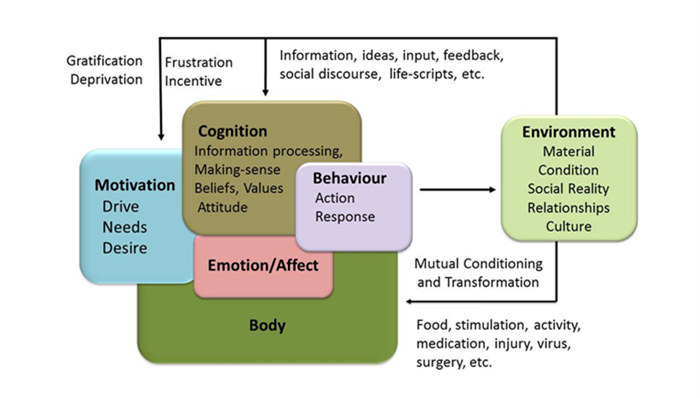SSLD: Approach to Sleeping Well
Human Behavior and the Environment

Factors of Sleeping
Our sleep pattern is affected by processes in all the six domains:
- Environmental
- - Chemical substance affecting sleep: stimulant (caffeine), medication, hypnotic substance in food (e.g., tryptophan)
- - Physical source of discomfort (hard rigid mattress),
- - Distraction (noise, light, snoring partner),
- - Social reality: Interpersonal relationships, work related demands (e.g., shift duty, overtime)
- Biological program
- - Neurophysiology
- - Stages of sleep
- - Medical condition, pain, postpartum hormonal changes
- - Genetic pre-disposition
- - Bio-rhythm
- - Muscle tension
- - Shallow breathing
- Motivation
- - Achievement drive (e.g., need high energy and performance)
- - Mastery and control over self, or social and interpersonal reality (e.g., relationships)
- - Unmet needs (e.g., sex, intimacy)
- Cognitive
- - Negative automatic thoughts, negative sleep thoughts
- - Rigid expectation increasing anxiety and sense of failure/defeat (e.g., 8 hours myth)
- - Self blaming, self degradation: Other people can do it, only I can't
- - Negative extension, exaggeration: If I can't sleep, my health will deteriorate
- - Cannot make sense: Why can't I sleep? Have I done something wrong? What's wrong with me?
- - Absolute, all-or-nothing dichotomies
- - Defeatism
- - Religion, faith, philosophy of life
- Emotional
- - Fear
- - Anxiety
- - Guilt, shame
- - Anger, frustration, agitation
- Behaviour
- - Fighting, forcing
- - Agonizing
- - Multiple attempts at ineffective strategies (restless rolling and tossing)
Program Characteristics
- Based on SSLD principles, the intervention program will address factors and processes affecting sleep quality of the participants in all the domains of environment (social and physical), body and biological program, motivation, cognition, affect and emotion, and behabior.
- Multiple contingency thinking: Not a standard method for everyone; each person will develop his or her own strategy to sleep well.
- Many components of the program (e.g., relaxation and breathing, how to modify cognitive processes) will allow for individual differences, embracing the principle of equifinality.
- Many of the current thinking and behaviours that interferes with quality sleep are motivated. It's important to recognize those needs/drives; and to address them within the parameters of the program.
- Participants are going to learn and develop new strategies that will help to create more favourable conditions for sleeping well.
Self Efficacy
Self-efficacy is a key concept in social cognitive theory, one of the conceptual building blocks of SSLD. Self efficacy is understood as beliefs in one's capability to organize and execute the courses of action required to manage prospective situations (Bandura, 1977b, p. 2). In everyday language, we may be referring to similar concepts such as self-confidence and self-sufficiency. The major idea is that we believe in our ability to manage situations in life. This entails the ability to accurate assess the situation, establishing a sense of purpose and direction, developing appropriate strategies and mastering relevant skills to achieve our goals in these situations.
Self Efficacy
- Belief in one's ability to deal effectively with situations in life effectively - in that we are able to attain our desired outcome or goals in those situations.
- Confidence or proficiency in the necessary interpersonal or social skills (specific courses of action) and knowledge of how they can be organized (strategies) to deal with the situation effectively.
Back to the top
Program Components
Two weekly meetings with one focusing on Body Work and sharing and support, the other focusing on cognitive and behavioural strategies.
- Body Work
- Body awareness
- Systematic Relaxation
- - Rhythmic breathing
- - Relaxation of voluntary muscles
- - Progressive relaxation combining breathing and muscular relaxation
- Stretching and relaxation: combining Yoga, Feldenkrais, and movement procedures
- Physical activities and sleep.
- Experiential Sharing and Mutual Support
- Participants have diverse experience of difficulties with sleep
- Sharing reduces stress related to sense of isolation or particularization - I am not alone
- Opens up alternative perspectives
- Sharing will facilitate information sharing, skills and strategies learning, and emotional support
- Cognitive Domain
- Helpful perspective on sleep
- - Multiple domains
- - Individual difference
- - Self-efficacy and positive expectancy: I can learn to do something to make a difference
- Information on sleep and misinformation
- - Stages of sleep
- - 8 hour myth
- - Factors affecting sleep quality
- - Sleep efficiency
- - Medication
- - Food and diet
- - Sleep and napping
- Review life circumstances with reference to sleep
- Addressing negative ideas regarding sleep
- Positive reframing
- Helpful perspective on sleep
- Emotional Domain
- Awareness of emotions associated with sleep (e.g., over-arousal, anger, frustration, sadness, depression, etc.)
- Effective emotional management: Connection, ownership, expression, ventilation and equilibrium
- Humor and emotion
- Quest for pleasure
- Motivation
- Motivation for wakefulness (e.g., wish to speak to family member who comes home late, fear and vulnerability)
- Unmet or unfulfilled needs
- Motivation for change
- Behavioral Domain
- Self monitoring: Sleep Diary, recording and charting
- Incremental take-home tasks (PFA, preparing for future action)
- Specific strategies (e.g., Stress management, relaxation, establishing emotional and social support, stimulus control, reconstructing the sleeping environment, cultivating sleep promoting habits, etc.)
- Forming buddy system for reminder, encouragement, and support